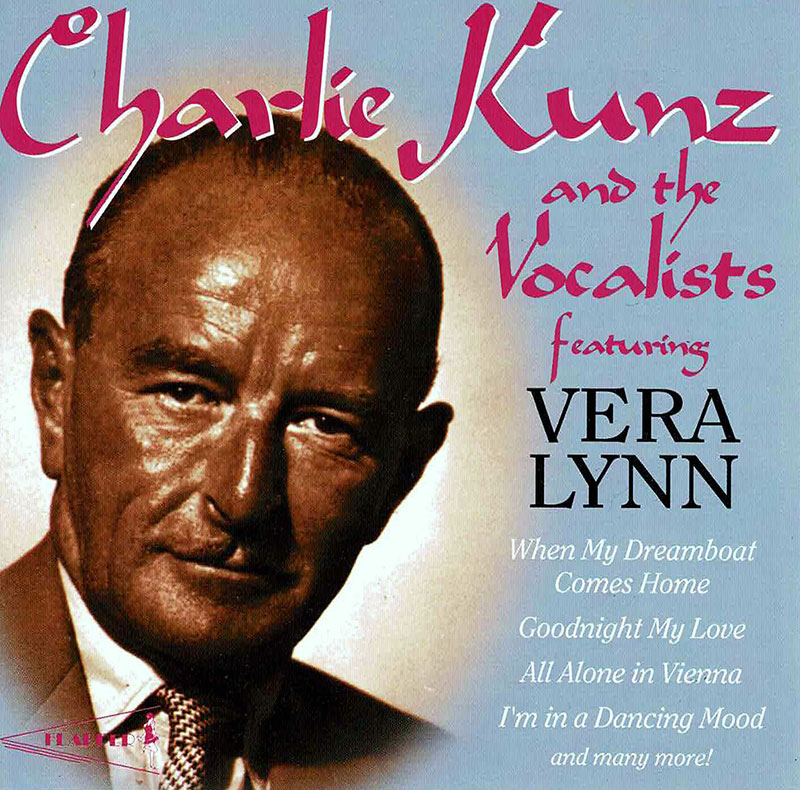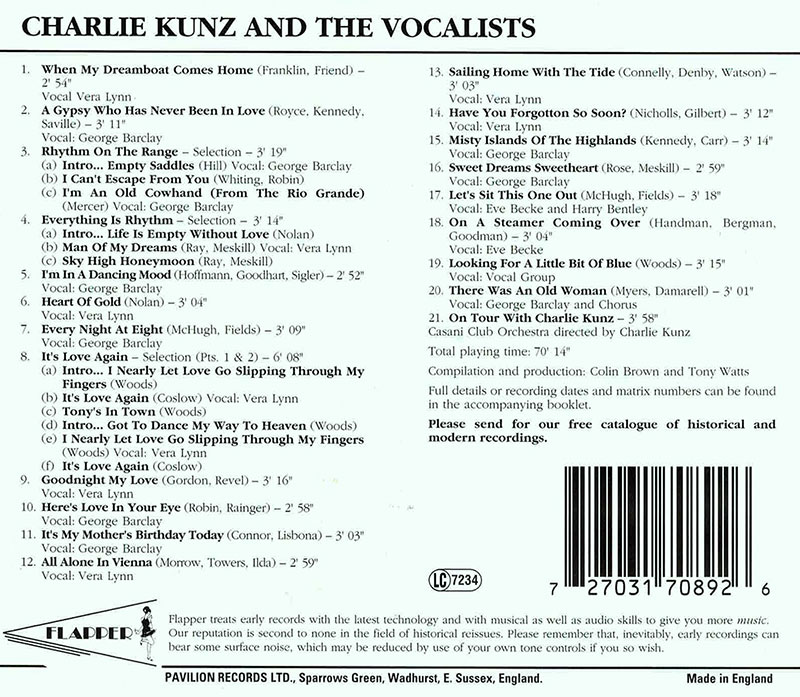Logowanie
Mikołaj - ten to ma gest!
Elton John, The Mamas & The Papas, Cat Stevens, Rod Stewart, Bobbie Gentry, Stevie Wonder, Engelbert Humperdinck
Memory Lane
Edycja Numerowana - 1000 egzemplarzy w skali światowej
RACHMANINOV, Eiji Oue, Minnesota Orchestra
Symphonic Dances / Vocalise
Best Recordings of 2001!!! NAJCZĘŚCIEJ KUPOWANA PŁYTA Z RR!
Karnawał czas zacząć!
Music of Love - Hi-Fi Latin Rhythms
Samba : Music of Celebration
AUDIOPHILE 24BIT RECORDING AND MASTERING
CHOPIN, LISZT, DEBUSSY, DVORAK, Gerhard Oppitz
Dances romantiques - A fantastic Notturno
Wzorcowa jakość audiofilska z Clearaudio
Winylowy niezbędnik
ClearAudio
Double Matrix Professional - Sonic
najbardziej inteligentna i skuteczna pralka do płyt winylowych wszelkiego typu - całkowicie automatyczna
Charlie Kunz and the Vocalists
Charlie Kunz and the Vocalists

- 1. When My Dreamboat Comes Home (Franklin, Friend)-2' 54"
- (Rec. Jan. 1937: Mat. No. F 2135: Rex 8964) Vocal Vera Lynn
- 2. A Gypsy Who Has Never Been In Love (Royce, Kennedy, Saville)-3' 11"
- (Rec. March 1937: Mat. No. F 2240: Rex 9011) Vocal: George Barclay
- 3. Rhythm On The Range-Selection-3' 19"
- (a) Intro... Empty Saddles (hill) Vocal: George Barclay
- (b) I Can't Escape From You (Whiting, Robin)
- (c) I'm An Old Cowhand (From The Rio Grande) (Mercer) Vocal: George Barclay (Rec. Dec. 1936: Mat. No. F 2104: Rex 8945)
- 4. Everything is Rhythm-Selection- 3' 14"
- (a) Intro... Life Is Empty Without Love (Nolan)
- (b) Man Of My Dreams (Ray, Meskll) Vocal: Vera Lynn
- (c) Sky High Honeymoon (Ray, Meskill) (Rec. Dec. 1936: Mat. No. F 2105: Rex 8945)
- 5. I'm In A Dancing Mood Hoffmann, Goodhart, Sigler) - 2'52"
- (Rec. Oct. 1936: Mat. No. F 2056: Rex 8917) Vocal: George Barclay
- 6. Heart Of Gold (Nolan)-3'04"
- (Rec. May 1936: Mat. No. F 1843: Rex 8789) Vocal: Vera Lynn
- 7. Every Night At Eight (McHugh, Fields) -3'09" (Rec. Oct. 1935: Mat. No. F 1556: Rex 86,23) Vocal: George Barclay
- 8. It's Love Again- Selection (Pts. 1 & 2) - 6'08"
- (a) Intro... I Nearly Let Love Go Slipping Through My Fingers (Woods)
- (b) It's Love Again (Coslow) Vocal: Vera Lynn
- (c) Tony's In Town (Woods)
- (d) Intro... Got To Dance My Way To Heaven (Woods)
- (e) I Nearly Let Love Go Slipping Through My Fingers (Woods) Vocal: Vera Lynn
- (f) It's Love Again (Coslow)
- (Rec. Sep. 1936: Mat. Nos. F 1982/3: Rex 8877)
- 9. Goodnight My Love (Gordon, Revel) -3'16" (Rec. March 1937: Mat. No, F 2238: Rex 9010) Vocal: Vera Lynn
- 10. Here's Love In Your Eye (Robin, Rainger)-2'58" (Rec. Ian 1937: Mat. No. F 2134: Rex 8964) Vocal: George Barclay
- 11. It's My Mother's Birthday Today (Connor, Lishona)-3' 03"
- (Rec. Nov. 1935: Mat. No. F 1599: Rex 8660) Vocal: George Barclay
- 12. All Alone In Vienna (Morrow, Towers, Ilda)-2' 59" (Rec. March 1937: Mat. No. F 2241: Rex 9011) Vocal: Vera Lynn
- 13. Sailing Home With The Tide (Connelly, Denby, Watson)-3' 03"
- (Rec. Nov. 1935: Mat. No. F 1598: Rex 8659) Vocal: Vera Lynn
- 14. Have You Forgotton So Scion? (Nicholls, Gilbert) - 3-12"
- (Rec. Dec. 1936: Mat. No. F 2102: Rex 8944) Vocal: Vera Lynn
- 15. Misty Islands OfThe Highlands (Kennedy, Carr) -3' 14"
- (Rec. Nov. 1935: Mat. No. F 1580: Rex 8639) Vocal: George Barclay
- 16. Sweet Dreams Sweetheart (Rose, Meskill) - 2'59" (Rec. Nov. 1935: Mat. No. 1600: Rex 8660) Vocal: George Barclay
- 17. Let's Sit This One Out (McHugh, Fields) - 3' 18" (Rec. 2/1/34: Mat. No. S 3476: Sterno 1337) Vocal: Eve Becke and Harry Bentley
- 18. On A Steamer Coming Over (Handman, Bergman, Goodman)-3' 04"
- (Rec. 2/7/34: Mat. No. L 1416: Plaza P 199) Vocal: Eve Becke
- 19. Looking For A Little Bit Of Biue (Woods)-3' 15" (Rec. 12/1/35: Mat. No. S 4169: Sterno 1564) Vocal: Vocal Group
- 20. There Was An Old Woman (Myers, Damarell) - 3'01"
- (Rec. 12/11/34: Mat. No. L 1975: Plaza P 340) Vocal: George Barclay and Chorus
- 21. On Tour With Charlie Kunz-3' 58"
- Charlie Kunz and the Vocalists - orchestra
To jedna z najbardziej frapujących historia życia i twórczości, materiał na wspaniały melodramat, a przynajmniej film muzyczny z epoki króla muzyki - swingu. Charlie Kunz bez reszty poświęcił się muzyce. Karierę rozpoczął jako członek orkiestry dętej w rodzinnym miasteczku Allentown. Róg francuski nie był jednak instrumentem, ktory w pełni satysfakcjonował młodego człowieka. Fortepian! Ileż możliwości, jaka elegancja, i zawsze na pierwszym planie! W wieku lat szesnastu - założył i prowadził własną orkiestrę. W 1922 roku wyjechał do Anglii jako członek orkiestry koncertującej w najważniejszych klubach i kawiarniach Londynu. To był jego muzyczny uniwersytet. Mógł już teraz samodzielnie ruszać na podbój świata ze swoją muzyką. Czarująca, wspaniał i wymarzona pta na każdy wieczór w gronie przyjaciół, z nutką nostalgii, zadumy i westchnienia do tych pięknych czasów, kiedy królował swing... Born in the United States on 18 August 1896, Charlie Kunz's initial musical experience came when he played French horn in a brass band based in his home town of Allentown. Deciding that the instrument was not for him he rc-studied as a pianist. His progress on the keyboard was so rapid that by the age of sixteen he was leading his own band. In 1922 Charlie Kunz traveled to England as a member of an orchestra which was to give concerts at a number of notable London locations including the Trocadero, the Popular Cafe, the Empress Rooms and the Grafton Galleries. Kunz found life so congenial in the capital city that he decided to stay on when his colleagues returned to America. He soon got into the swing of London's musical life with its exclusive restaurants and night spots and for eight years from 1925 led a band at the Chez Henri Club where he became one of four American bandleaders to make their name in London; the others were Roy Fox, Carroll Gibbons and Jack H Harris Charlie Kunz was something of a rarity amongst the West End leaders in that he actually played an instrument! In 1933 he was finally persuaded to sign a contract to head a group at former international ballroom dancing champion Santos Casani's new club in Regent Street. Once the band had settled in it began to feature regularly on the radio, in those days a medium which did much to popularize dance band music. Introduced by his theme tune `Clap Hands, H Here Comes Charlie' the Casani Club Orchestra presented high-class versions of the popular songs of the day interspersed with medleys of waltzes, tangos and other dances that appealed to patrons of the club and the listening public alike. Almost as soon as his residency at the Casini Club started, Charlie Kunz began to make records. He had cut a few sides for Columbia while at Chez Henri, but his true recording career began in 1933. Initially released on such labels as Steno, 4-in-1, Plaza, Peacock, Homochord, Lewis, and Solex, by 1935 he had switched to Rex before finally appearing on the familiar Decca `F' series in 1941. As often happened in those far off days many of the records were released on different labels under different names, so while the Casani Club Orchestra directed by Charlie Kunz were credited on the major labels, the minor companies had the same discs bearing the names of dozens of imaginary groups such as Harold Cox and his Serenaders, Maurice Dixon and his Dance Band, The Twelve Cavaliers (even though the band usually numbered mine pieces) and Al Gold and his Band. Caveat emptor certainly applied as the unwary record collector could quite easily end up with the same performance on three or four different labels. The first Charlie Kunz piano medleys were issued on Rex in the mid-'thirties, while as previously noted the young Vera Lynn made her recording debut with the Casani Club band. Other stalwart singers of the British dance band scene including George Barclay and the beautiful Eve Becke were also regularly featured. Once Charlie Kunz's solo piano recordings became universally popular he deserted the Casani Club in favour of frequent visits to the recording studio and tours of the then huge circuit of variety theatres. The solo public appearances murst have purgatory for Kunz, am intensely shy man who suffered badly from stage fright. Interestingly in the early 'forties Kunz made a few sides for Decca with a group of studio musicians under the name of Charlie Kunz and his Ballroom Orchestra. Obviously his name still carried some weight amongst the loves of strict-tempo dance music. One of the more bizarre footnotes in the history of popular music in Britain was a rumour that circulated during the war that Charlie Kunz was, in fact, a German agent who was sending morse code messages to the enemy during his broadcasts. Some of the more hysterical conspiracy theorists even began to campaign for the pianist to be imprisoned in the Tower of London. In 1951 Charlie Kunz was honored to be asked to star in the Royal Variety Performance in which he appeared in a special piano spot together with Carroll Gibbons, Billy Thorburn, Ivor Moreton and Dave Kaye. If he suffered with his nerves on ordinary engagements, one cam only guess as to how he coped on thin royal occasion. Quite remarkably Charlie Kunz continued to record his piano medleys almost up to the time of his death at the age of sixty-one despite increasingly debilitating arthritis. Rapidly changing musical trends not withstanding he retained his popularity right through the rock and roll era; one of his records even making the UK Singles Chart in 1954; all proof that there is always a place for quality music expertly performed. © 1997 TONY WATTS





























